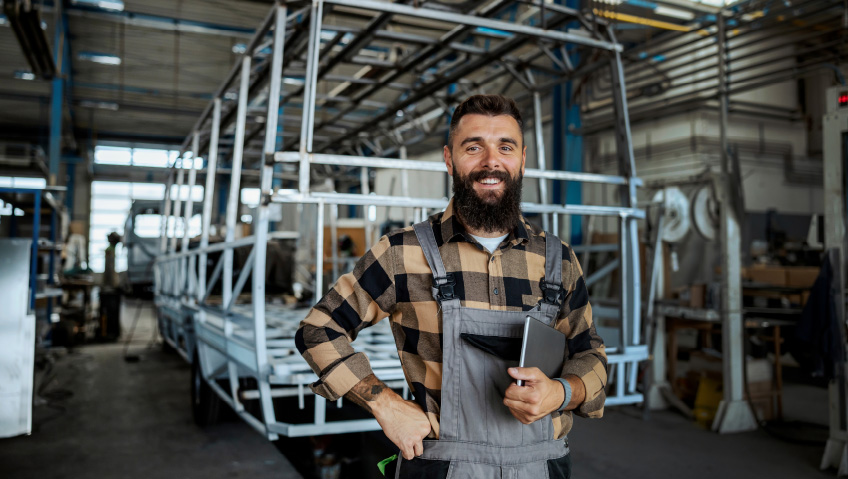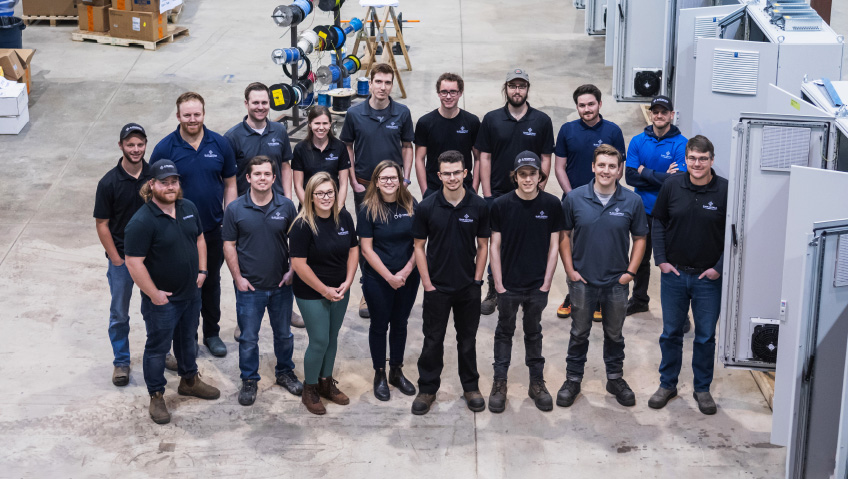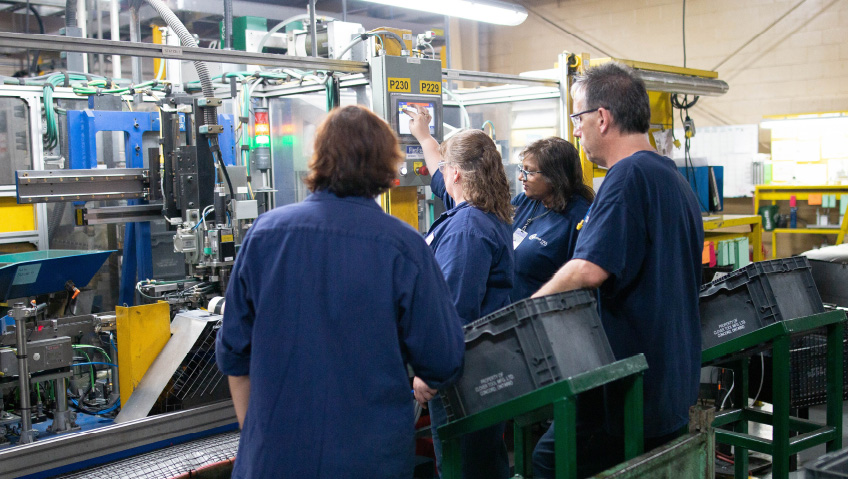N95 masks. Hand sanitizer. PPE. Respirators. Plexiglass barriers. Social distance signage. Rapid Testing Kits. Contact tracing apps. Vaccine against a previously unknown Coronavirus. In January 2020, who would have thought there was a need for manufacturers to ramp up production of any of these items? Or to deal with the grim reality that more body bags were required? But by March, the need for all these items and more was real, and manufacturers struggled to meet demands amid the growing public health crisis of a global pandemic.
According to the Oxford Dictionary, a crisis “is a time of intense difficulty, trouble, or danger,” and also, “a time when a difficult or important decision must be made.” But a crisis can also represent an opportunity to meet the danger head on and bring solutions to halt or even reverse its trajectory.
In March of 2020, when COVID-19 began to spread like wildfire and states and provinces went into lockdown, the health care system was woefully under stocked with basic equipment. There was an insufficient supply of N95 masks and PPE for health care workers, not enough respirators, not enough of anything to combat a health crisis the like of which had not been seen since the H1N1 Influenza Pandemic of 1918-1920, which came in three waves, each more deadly than the last, until it wore itself out, leaving a global death toll of over 50 million.
Obviously, frontline workers are owed a huge debt of gratitude for the work they’ve done since the outbreak began, and continue to do a year later.
But there are also unsung heroes in this story; they are the manufacturers who rose to the occasion, and either ramped up their production of medical equipment or adapted their existing facilities to produce what was required when disruptions in the overseas supply chain occurred.
Abhijit Bhide, Managing Director, Bank of America Global Banking and Markets, explains in his article Thriving in a new manufacturing world that, “even when the pandemic subsides, it will leave behind a changed economic landscape for manufacturers and their customers; that a less global, more local economy presents opportunities for those able to adapt quickly, and that focussing on automation and targeting areas of the economy likely to grow, could help companies succeed moving forward.”
Michael Gillespie, Partner, National Manufacturing Leader, writing for BDO Canada, expresses similar considerations. “Significant reliance on workforce and a complex supply chain has led to production restrictions, and in some cases, closures. However, opportunities continue to exist for companies looking for assistance to pivot and innovate.”
Gillespie points to the critical need for innovation, process improvements, improved supply chain management and investments in information technology and automation. In addition, it is critical for manufacturers to consider real needs in a time of crisis and do their best to fill them.
Manufacturing what people need
What consumers wanted and thought they ‘needed’ a year ago has changed dramatically. People no longer think they ‘need’ to travel, since non-emergency travel is discouraged as potentially dangerous, or ‘need’ an expensive business wardrobe since they are now working from home. As a result, the OEMs who supply the aviation and the automotive industry or manufacturers focussed on the fashion, hospitality, or cosmetic industry are, or likely will be, adversely affected.
Meanwhile, the public has turned to manufacturers in the health care and technology sectors for what they really do need.
First and foremost, of course, are health care items. N95 masks, personal protective equipment, respirators, and sanitizer were in short supply at the beginning of the pandemic because of disruptions in the supply chain or because they were being manufactured offshore. As a result, some smaller, local manufacturers with the ability to be flexible began producing some of what was needed. Sporting goods manufacturers, for example, turned baseball uniforms into hospital gowns and Plexiglass hockey masks into face shields.
As the pandemic unfolded and it was realized that asymptomatic individuals could spread the virus, there arose a pressing need for antibody tests and rapid testing kits so that individuals who tested positive for COVID-19 could be isolated and their contacts traced, which led to contact tracing applications. All of this led to manufacturers in the health care sector investing more and more in artificial intelligence and big data analysis.
Fortunately, the U.S. does have the capability of manufacturing vaccines onshore. Pfizer’s COVID-19 vaccine, developed with BioNTech and the first to be given emergency approval in several countries including the UK, Bahrain, Canada, and the U.S., is manufactured at Pfizer’s facilities in Kalamazoo, MI and in Belgium. Although Pfizer’s Kalamazoo facility could supply the U.S., Canada’s supplies were shipped from Belgium at the beginning of the pandemic. Meanwhile Moderna’s vaccine, the second to receive FDA approval, is manufactured by the Lonza Group in Portsmouth, NH and packed by Catalent in their facility in Bloomington, IN.
On January 11, 2021 Canada’s Global News reported that Medicago, a biopharmaceutical company based in Quebec, is prepared to move into Phase 3 trials with its plant-based vaccine, and if successful and approved, could be available for use by the second half of this year. The company’s manufacturing site in Canada, however, is still under construction and won’t be ready until late in 2023, or even 2024. That doesn’t mean however, that the vaccine won’t be produced. Instead, pending approval, it will be manufactured at Medicago’s plant in North Carolina, with only 10 percent “made in Canada” at its pilot plant west of Quebec City.
If proven to be safe and efficacious, Medicago’s vaccine offers a major advantage over Pfizer’s and Moderna’s vaccines as it doesn’t have to be stored at the exceptionally low temperature Pfizer’s does, -70°C, in order to remain stable. Still, for the foreseeable future, Pfizer and Moderna, which requires a slightly less frigid temperature, are the only vaccines available in North America, thus giving refrigeration equipment manufacturers an unexpected opportunity.
Deep freeze storage is just one example of many such opportunities for manufacturers who are flexible enough to adapt and respond quickly. Since so many people are currently working and/or studying from home, as a result of office and school closures, there’s a critical need for upgraded laptops or tablets that will support video conferencing platforms, such as Zoom or Teams, widely used by businesses to stay connected both internally and with customers. Certainly, they existed before the pandemic, but they are now the lifeblood of business operations and have fundamentally changed how employees connect with colleagues, how friends and family connect in this time of isolation, and how patients connect with medical professionals.
With restrictions that reduce accessibility to medical facilities, mobile devices that monitor blood glucose levels, blood pressure, test for a variety of conditions, and even register electrocardiogram results, allow people to make informed calls to health care providers and reduce wait times. Mobile diagnostic devices will also accelerate opportunities to begin treatments for a number of conditions which, if allowed to continue undiagnosed or not monitored, will decrease chances of survival should the patient contract COVID-19.
With gyms and fitness centres viewed as virus-spreading sites, more and more people are looking to purchase fitness equipment they can use in the safety of their homes, to maintain their health through an active lifestyle. There’s also been an increased demand for outdoor exercise equipment – bicycles, skis, skates, runners, along with exercise clothing. Spas and salons are also faced with closures or limited access for the same reason, resulting in demand from consumers for personal care items. All of these demands offer viable opportunities for manufacturers to meet public health needs.
Manufacturing beyond the pandemic
While the notion of a global pandemic like this was explored in science fiction, no one was prepared for it. And now we don’t really know when it will end, or what ‘normal’ will look like on the other side. Vaccines have been approved and are being administered, but it is uncertain how long they will be efficacious, or if new variants of the COVID-19 virus will be resistant to them.
Even the best-case scenarios are now suggesting it could be 2022 or even 2023 before the majority of the world’s population is immunized and it’s likely we will not return to the pre-pandemic world even when this pandemic ends. This is not necessarily a bad thing as there was much wrong with that world, as it applies to manufacturing.
The trend toward offshore manufacturing that began in the late 1990s and continued until now resulted in the predictable outcome of cheaper consumer goods at the price of massive job loss in North America – that we knew. But what wasn’t predicted was the difficulty that would be created during a pandemic through break-downs in critical supply chains affecting equipment intended for public health. Or what would happen when COVID-19 outbreaks spread through the workforce in huge food processing plants that supplied half the country, thereby threatening food security.
Manufacturers with the best chances of succeeding in this post-pandemic world, Bhide argues, are small and medium sized ones whose needs are filled by local supply chains and who are open to innovation, or modification of existing products and to automation which will help protect workers’ health by minimizing contact. He also notes “uncertainty about further government stimulus in the year to come” as a major challenge facing manufacturing.
While manufacturers are doing their utmost to deal with this unprecedented public health crisis and taking advantage of the opportunities it has created, especially in the health, technology, and home products sector, they can’t do it all by themselves. There needs to be a political will, in both Canada and the U.S. to provide stimulus packages, government incentives for research and development for small and medium size manufacturers, as Gillespie noted.
Although he didn’t mention specifics in his brief article, the January 11 announcement regarding Medicago’s lack of a facility to actually manufacture speaks volumes to the lack of government foresight in preparing for a public health crisis.
As long ago as 2005, the then-CEO Andy Sheldon, concerned about the possibility of a pandemic, decided to move the Medicago into vaccine development, but despite frequent meetings with the federal government led by Steven Harper, no funding was forthcoming. Instead, in 2009, under the Obama administration, in a response to the deadly swine influenza epidemic, Medicago won a contract worth USD $21 Million to manufacture 10 million doses of the flu vaccine and with that and an infusion of its own cash, was able to develop the plant in South Carolina.
The Global News article, Canada’s COVID-19 Contender, authored by Carolyn Jarvis and Emanuela Campanella, goes on to note that, “it wasn’t until the pandemic struck that the money and a purpose came together.” In March, the federal government under Justin Trudeau announced it would fund Medicago’s COVID-19 vaccine efforts and in September signed an agreement worth up to $173 million to accelerate Medicago’s vaccine development, secure doses, and complete the manufacturing plant.
Jarvis and Campanella explain that Innovation, Science and Economic Development Canada has acknowledged a “decades-old decline” in federal funding and say it is now “actively working to support the rebuilding of biomanufacturing capacity in Canada.”
There are lessons that stand out, if we are willing to listen. We must be self-sufficient in times of crisis. We need safe working environments for our manufacturing workforce. We need to have medical diagnostic and treatment equipment with timely access to replacement parts. We need food security. We need the capacity to manufacture vaccines within our own borders. If we learn these lessons, we will be better prepared to survive this pandemic, and the next crisis after that. Let us build resilience into our manufacturing sectors.






